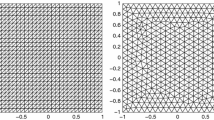Abstract
We are interested in the numerical approximation of non-linear hyperbolic problems. The particular class of schemes we are interested in are the so-called Residual Distribution (RD) schemes. In their current form, they rely on the Lagrange interpolation of the point values of the approximated functions. This interpretation of the degrees of freedom as point values plays a fundamental role in the derivation of the schemes. The purpose of the present paper is to show that some non-Lagrange elements can also do the job, and maybe better. This opens the door to isogeometric analysis in the framework of RDS schemes.
Similar content being viewed by others
References
Roe, P.L.: Approximate Riemann solvers, parameter vectors, and difference schemes. J. Comput. Phys. 43 (1983)
Ni, R.-H.: A multiple grid scheme for solving the Euler equations. AIAA J. 20(11), 1565–1571 (1981)
Hughes, T.J.R., Franca, L.P., Mallet, M.: A new finite element formulation for CFD, I: symmetric forms of the compressible Euler and Navier-Stokes equations and the second law of thermodynamics. Comput. Methods Appl. Mech. Eng. 54, 223–234 (1986)
Hughes, T.J.R., Mallet, M.: A new finite element formulation for CFD, III: the generalized streamline operator for multidimensional advective-diffusive systems. Comput. Methods Appl. Mech. Eng. 58, 305–328 (1986)
Johnson, C.: Numerical Solution of Partial Differential Equations by the Finite Element Method. Cambridge University Press, Cambridge (1987)
Struijs, R., Deconinck, H., Roe, P.L.: Fluctuation splitting schemes for the 2D Euler equations. Computational Fluid Dynamics, VKI-LS 1991-01 (1991)
Paillère, H., Carette, J.-C., Deconinck, H.: Multidimentional upwind and supg methods for the solution of the compressible flow equations on unstructured grids. Computational Fluid Dynamics, VKI-LS 1994-05 (1994)
van der Weide, E., Deconinck, H., Issmann, E., Degrez, G.: Fluctuation splitting schemes for multidimensional convection problems: an alternative to finite volume and finite element methods. Comput. Mech. 23(2), 199–208 (1999)
Csík, Á., Ricchiuto, M., Deconinck, H.: A conservative formulation of the multidimensional upwind residual distribution schemes for general nonlinear conservation laws. J. Comput. Phys. 179(2), 286–312 (2002)
Abgrall, R.: Toward the ultimate conservative scheme: following the quest. J. Comput. Phys. 167(2), 277–315 (2001)
Abgrall, R., Mezine, M.: Construction of second-order accurate monotone and stable residual distribution schemes for steady problems. J. Comput. Phys. 195(2), 474–507 (2004)
Abgrall, R., Mezine, M.: Construction of second order accurate monotone and stable residual distribution schemes for unsteady flow problems. J. Comput. Phys. 188(1), 16–55 (2003)
Abgrall, R., Roe, L.P.: High-order fluctuation schemes on triangular meshes. J. Sci. Comput. 19(1–3), 3–36 (2003)
Abgrall, R., Shu, C.W.: Development of residual distribution schemes for the discontinuous Galerkin methods: the scalar case. Commun. Comput. Phys. 9, 376–390 (2009)
Hubbard, M.E.: A framework for discontinuous fluctuation distribution. Int. J. Numer. Methods Fluids 56(8), 1305–1311 (2008)
Hughes, T.J.R., Cottrell, J.A., Bazilevs, Y.: Isogeometric analysis: CAD, finite elements, NURBS, exact geometry and mesh refinement. Comput. Methods Appl. Mech. Eng. 194(39–41), 4135–4195 (2005)
Ciarlet, P.G., Raviart, P.A.: General Lagrange and Hermite interpolation in R n with applications to finite element methods. Arch. Ration. Mech. Anal. 46, 177–199 (1972)
de Boor, C.: A practical guide to splines. Applied Mathematical Sciences, vol. 27. Springer, Berlin (1978)
Abgrall, R., Larat, A., Ricchiuto, M., Tavé, C.: A simple construction of very high order non oscillatory compact schemes on unstructured meshes. Comput. Fluids 38(7), 1314–1323 (2009)
Rogers, D. F.: An Introduction to NURBS: with Historical Perspectives. Morgan Kaufman, San Mateo (2001)
Guckenheimer, J.: Shocks and rarefactions in two space dimensions. Arch. Ration. Mech. Anal. 59, 281–291 (1975)
Strang, G., Fix, G.J.: An Analysis of the Finite Element Method. Prentice–Hall, Englewood Cliffs (1973)
Duruflé, M.: Intégration numérique et éléments finis d’ordre élevé appliqués aux équations de Maxwell en régime harmonique. PhD thesis, Université Paris Dauphine, february 2006
Author information
Authors and Affiliations
Corresponding author
Rights and permissions
About this article
Cite this article
Abgrall, R., Trefilík, J. An Example of High Order Residual Distribution Scheme Using non-Lagrange Elements. J Sci Comput 45, 3–25 (2010). https://doi.org/10.1007/s10915-010-9405-y
Received:
Revised:
Accepted:
Published:
Issue Date:
DOI: https://doi.org/10.1007/s10915-010-9405-y




